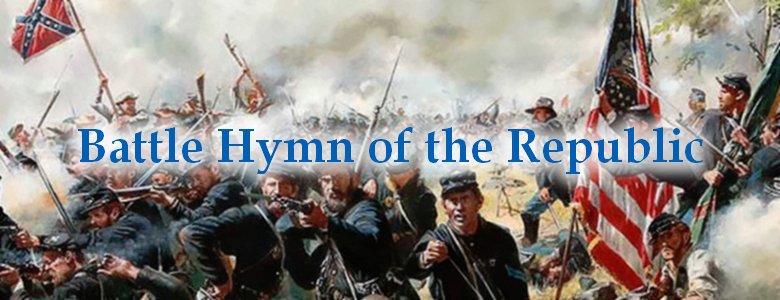PAT GAINES HOME PAGE

BATTLE HYMN OF THE REPUBLIC
In remembrance of American Independence Day, July 4, 1766, I have chosen to do a study of the hymn, “The Battle Hymn of the Republic,” written by Julia Ward Howe, Women’s Rights Activist, Songwriter, Poet, Civil Rights Activist (1819-1910). The “Glory, Hallelujah” tune was a folk hymn developed in the oral hymn tradition of camp meetings in the southern United States and first documented in early 1800s.
At a flag-raising ceremony at Fort Warren, near Boston, on Sunday May 12, 1861, the John Brown song, using the well-known “Oh! Brothers” tune and the “Glory, Hallelujah” chorus, was publicly played perhaps for the first time. Kimball’s battalion was dispatched to Murray, Kentucky early in the Civil War, and Julia Ward Howe heard this song during a public review of the troops outside Washington on Upton Hill, Virginia. Rufus R. Dawes, then in command of Company “K” of the Sixth Wisconsin Volunteer Infantry, stated in his memoirs that the man who started the singing was Sergeant John Ticknor of his company. Howe’s companion at the review, the Reverend James Freeman Clarke, suggested to Howe that she write new words for the fighting men’s song. Staying at the Willard Hotel in Washington on the night of November 18, 1861, Howe awoke with the words of the song in her mind and in near darkness wrote the verses to the “Battle Hymn of the Republic.”
Of the writing of the lyrics, Howe remembered: “I went to bed that night as usual, and slept, according to my wont, quite soundly. I awoke in the gray of the morning twilight; and as I lay waiting for the dawn, the long lines of the desired poem began to twine themselves in my mind. Having thought out all the stanzas, I said to myself, ‘I must get up and write these verses down, lest I fall asleep again and forget them.’ So, with a sudden effort, I sprang out of bed, and found in the dimness an old stump of a pen which I remembered to have used the day before. I scrawled the verses almost without looking at the paper.”
The words of the song intertwine the words describing Christ’s Second Coming as recorded in Revelation 19, with the Civil War and slavery.
[Revelation 19:11-16] (11) I saw heaven standing open and there before me was a white horse, whose rider is called Faithful and True. With justice he judges and wages war. (12) His eyes are like blazing fire, and on his head are many crowns. He has a name written on him that no one knows but he himself. (13) He is dressed in a robe dipped in blood, and his name is the Word of God. (14) The armies of heaven were following him, riding on white horses and dressed in fine linen, white and clean. (15) Coming out of his mouth is a sharp sword with which to strike down the nations. “He will rule them with an iron scepter.” He treads the winepress of the fury of the wrath of God Almighty. (16) On his robe and on his thigh he has this name written:“KING OF KINGS AND LORD OF LORDS.”
Both “John Brown” and “Battle Hymn of the Republic” were published in Father Kemp’s Old Folks Concert Tunes in 1874 and reprinted in 1889. Both songs had the same Chorus with an additional “Glory” in the second line: “Glory! Glory! Glory! Hallelujah!” Julia Ward Howe was the wife of Samuel Gridley Howe, the famed scholar in education of the blind. Samuel and Julia were also active leaders in anti-slavery politics and strong supporters of the Union. Samuel Howe was a member of the “Secret Six”, the group who funded John Brown’s work.
As a note of interest, I will add that my great-great-grandfather, AMOS HANNAH, was a neighbor of John Brown in Kansas and rode with Brown some during the “bloody wars” of Kansas.
BATTLE HYMN OF THE REPUBLIC
Mine eyes have seen the glory
of the coming of the Lord;
He is trampling out the vintage where
the grapes of wrath are stored;
He hath loosed the fateful lightning
of His terrible swift sword:
His truth is marching on.
Glory, glory, hallelujah!
His truth is marching on.
I have seen Him in the watch-fires
of a hundred circling camps,
They have builded Him an altar
in the evening dews and damps;
I can read His righteous sentence
by the dim and flaring lamps:
His day is marching on.
Glory, glory, hallelujah!
His truth is marching on.
I have read a fiery gospel writ
in burnished rows of steel:
“As ye deal with my contemners,
so with you my grace shall deal”;
Let the Hero, born of woman,
crush the serpent with his heel,
Since God is marching on.
Glory, glory, hallelujah!
His truth is marching on.
He has sounded forth the trumpet
that shall never call retreat;
He is sifting out the hearts
of men before His judgment-seat:
Oh, be swift, my soul, to answer Him!
be jubilant, my feet!
Our God is marching on.
Glory, glory, hallelujah!
His truth is marching on.
In the beauty of the lilies
Christ was born across the sea,
With a glory in His bosom that
transfigures you and me.
As He died to make men holy,
let us die to make men free,
While God is marching on.
Glory, glory, hallelujah!
His truth is marching on.
He is coming like the glory
of the morning on the wave,
He is Wisdom to the mighty,
He is Succour to the brave,
So the world shall be His footstool,
and the soul of Time His slave,
Our God is marching on.
Glory, glory, hallelujah!
His truth is marching on.